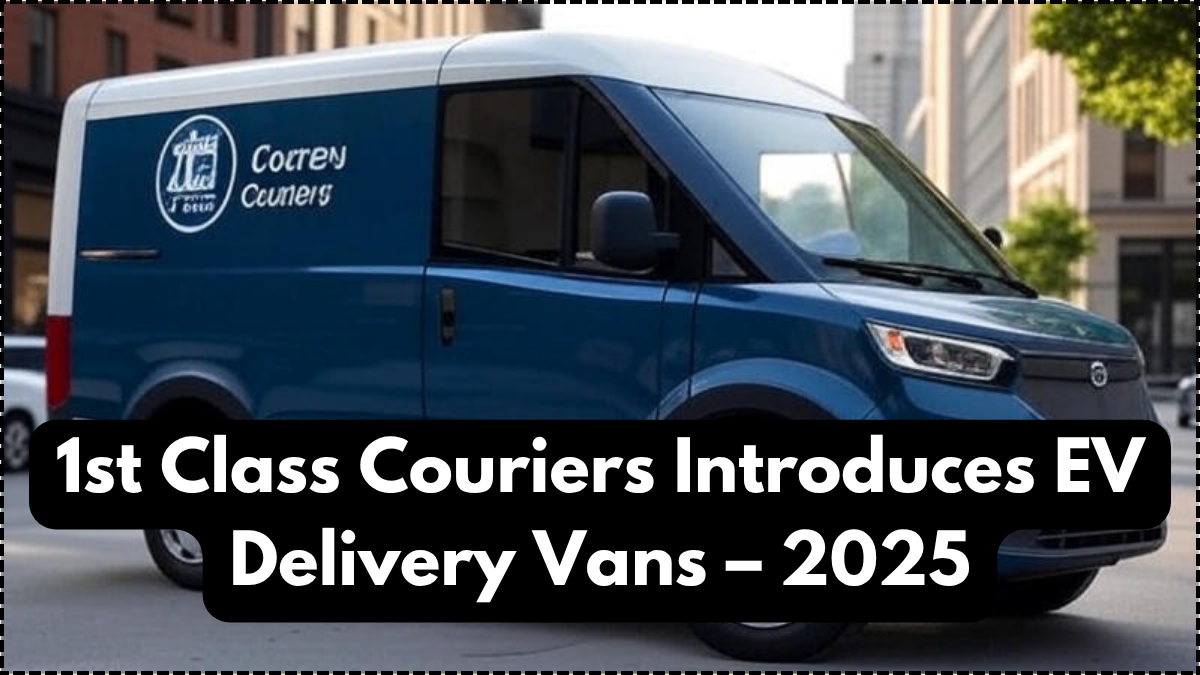In 2025, the UK logistics sector is going through a major transformation—and Courier Fleet EV Van Adoption UK 2025 is a prime example of how green technology is reshaping last-mile delivery. Leading the way is 1st Class Couriers, a nationwide delivery service that has officially begun integrating electric delivery vans UK into its fleet. This shift not only supports environmental goals but also introduces cost efficiencies and future readiness for upcoming emissions regulations.
As the government targets net-zero carbon emissions by 2050, transport remains one of the largest contributors to the UK’s carbon footprint. The courier industry, particularly with its high-volume, high-frequency delivery model, is under pressure to innovate. In this context, the Courier Fleet EV Van Adoption UK 2025 movement is more than just a trend—it’s becoming the industry standard.

Why 1st Class Couriers Is Moving Toward Electric Delivery Vans
1st Class Couriers has recognized the long-term benefits of transitioning to electric delivery vans UK across its national fleet. With over 800 delivery routes serviced daily, even a partial shift to EVs is significantly reducing fuel consumption and emissions.
The company cited several motivating factors:
-
Rising fuel costs impacting long-term profitability
-
Low-emission zone compliance requirements in major cities
-
Incentives and grants for fleet electrification
-
Customer preference for eco-conscious delivery services
The Courier Fleet EV Van Adoption UK 2025 initiative is also supported by advanced telematics and route optimization software, helping maximize the efficiency of electric vans while minimizing downtime due to charging.
Performance Comparison: Electric vs. Diesel Vans
To better understand the benefits of electric delivery vans UK, let’s look at a basic performance comparison between electric vans and traditional diesel ones in a courier setting:
| Parameter | Electric Vans (2025 Models) | Diesel Vans |
|---|---|---|
| Operating Cost per Mile | £0.09 | £0.21 |
| Average Range (Full Charge) | 220–250 miles | 300–350 miles |
| Maintenance Frequency | Low | Moderate to High |
| Emissions | Zero tailpipe | High CO₂ and NOx |
| Suitable for Urban Routes | Yes (ideal for stop-start driving) | Yes |
This table clearly shows why Courier Fleet EV Van Adoption UK 2025 is growing rapidly among delivery firms looking to future-proof operations.
Infrastructure and Charging Strategy
1st Class Couriers is not just buying electric vans—they are investing in a full infrastructure revamp. Their warehouses in London, Manchester, and Birmingham now feature high-speed charging stations designed to accommodate up to 20 EVs simultaneously. Additionally, the company has rolled out smart scheduling to avoid delivery disruptions during charging hours.
Key highlights of their charging strategy include:
-
Installation of 150kW rapid chargers at all major depots
-
Use of solar-powered grid backup systems
-
Fleet-wide battery monitoring with AI-based diagnostics
-
On-road fast-charging partnerships with Shell and BP Pulse
All of this supports the broader electric delivery vans UK initiative that aims to make EV-based logistics reliable, scalable, and low-risk.
Environmental and Economic Impact
By adopting EVs, 1st Class Couriers is aligning itself with government goals and achieving internal sustainability benchmarks. The company reports a projected reduction of 2,800 tonnes of CO₂ annually across its fleet—a major milestone in green logistics.
In economic terms, savings are being realized in several areas:
-
60% lower fuel costs
-
Reduced maintenance and repair frequency
-
Tax relief under UK’s EV support schemes
-
Improved driver retention due to quieter, smoother ride quality
Clearly, Courier Fleet EV Van Adoption UK 2025 is not just an ethical move but a financially sound one, especially as infrastructure and technology continue to mature.
Industry-Wide Implications
The success of 1st Class Couriers could inspire similar transitions across the logistics sector. With Amazon, DPD, and Royal Mail also exploring electric delivery vans UK, we are entering a decade of zero-emissions deliveries. Municipalities may soon mandate electric fleets for urban deliveries, and businesses without a green strategy could face penalties or contract limitations.
1st Class Couriers is already in talks with local councils and sustainability organizations to co-develop EV-only delivery zones in dense urban areas.
Conclusion: Leading the EV Charge in UK Logistics
In 2025, Courier Fleet EV Van Adoption UK 2025 is more than a headline—it’s a strategic blueprint for modern logistics. With visionary steps like smart infrastructure, data-driven EV performance management, and alignment with government policy, 1st Class Couriers is proving that the electric delivery vans UK movement is here to stay.
By embracing this shift now, logistics providers can not only reduce their environmental impact but also unlock long-term operational and financial gains. The roads of the future are electric—and they’re already arriving, one quiet van at a time.
FAQs
What is Courier Fleet EV Van Adoption UK 2025?
It refers to the growing trend of courier companies like 1st Class Couriers adopting electric delivery vans across their fleets in the UK to reduce emissions, lower costs, and meet regulatory standards.
Why are electric delivery vans UK becoming popular?
They offer low operating costs, zero emissions, smoother driving experiences, and compliance with clean air zones, making them ideal for modern urban logistics.
How many EVs does 1st Class Couriers plan to add in 2025?
The company plans to convert at least 60% of its total fleet to electric by the end of 2025, with ongoing evaluations for full conversion by 2027.
Do electric delivery vans have enough range for full-day deliveries?
Yes, current models used in 2025 offer 220–250 miles per full charge, which is sufficient for most urban and suburban delivery routes.
What infrastructure is needed for fleet electrification?
Companies need charging stations at depots, battery monitoring systems, and access to on-road rapid charging to support a reliable EV logistics network.
Click here to learn more